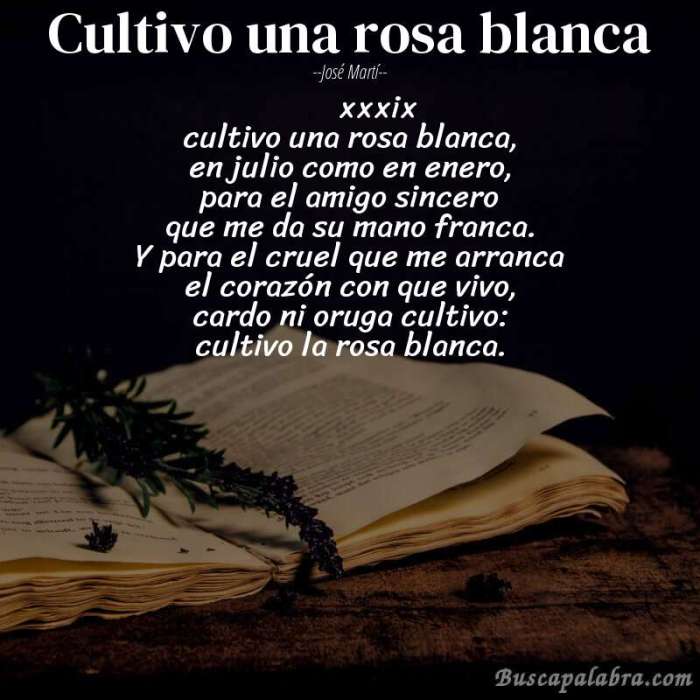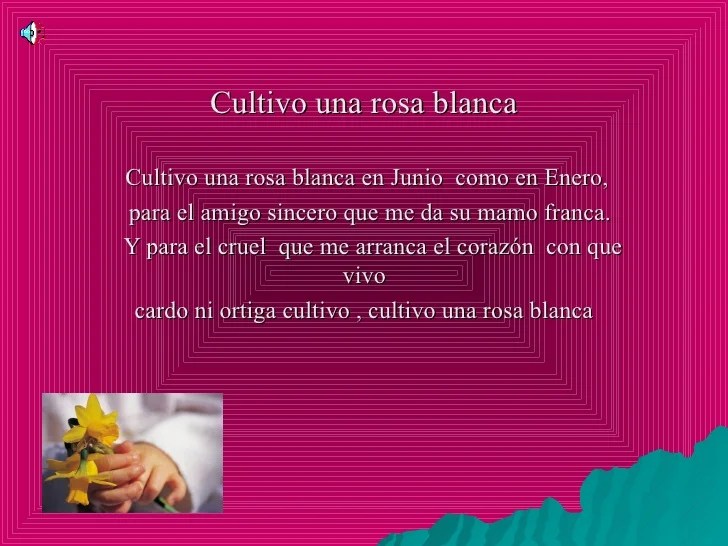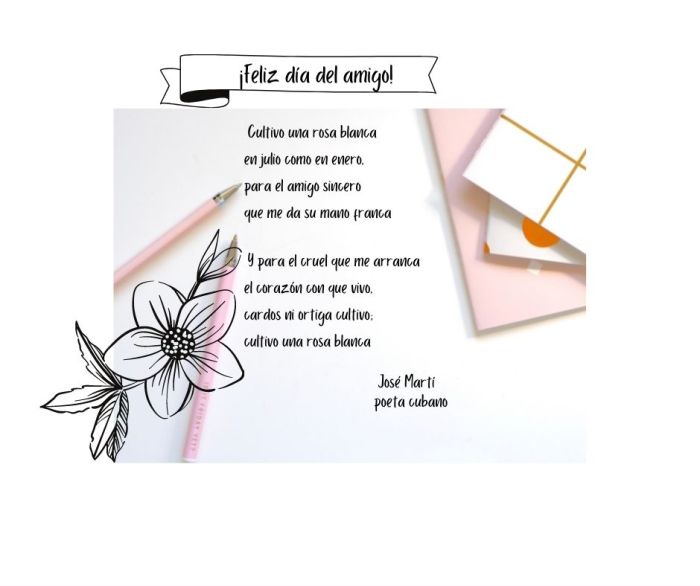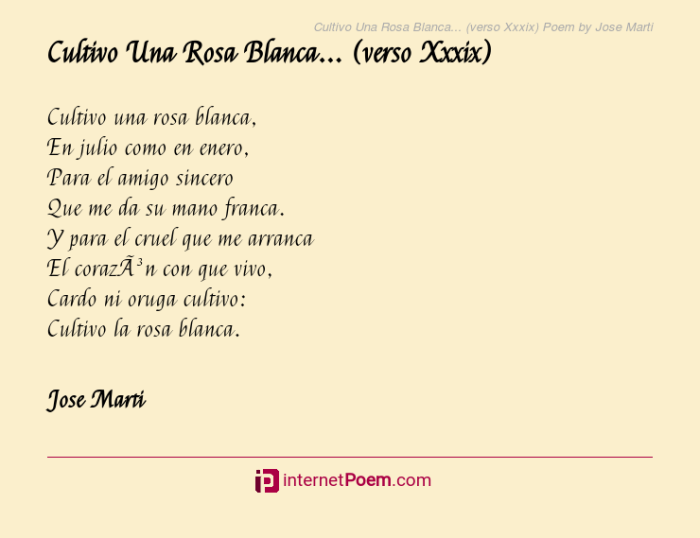Cultivo una rosa blanca poem – Embark on a literary journey with “Cultivo Una Rosa Blanca,” a captivating poem that unveils the intricate tapestry of human emotions. Its verses, adorned with imagery and symbolism, weave a tale of love, hope, and the indomitable spirit that resides within us all.
Delve into the poem’s structure, poetic devices, and historical context, as we unravel its profound message and timeless relevance.
Poem Structure and Analysis

José Martí’s “Cultivo una rosa blanca” is a sonnet, a type of poem with a specific structure and rhyme scheme. The poem consists of 14 lines, divided into two quatrains (four-line stanzas) and two tercets (three-line stanzas). The rhyme scheme is ABBA ABBA CDC DCD.
The poem is rich in literary devices. Imagery is used to create vivid pictures in the reader’s mind, such as the “rosa blanca” (white rose) and the “jardín de mi mente” (garden of my mind). Metaphor is used to compare the rose to the poet’s love, and symbolism is used to represent the rose as a symbol of purity and innocence.
Tone and Mood
The poem’s tone is one of quiet confidence and determination. The poet is sure of his love for the rose, and he is willing to protect it from harm. The mood of the poem is one of hope and optimism.
The poet believes that his love will endure, even in the face of adversity.
Theme and Meaning: Cultivo Una Rosa Blanca Poem

The central theme of “Cultivo una Rosa Blanca” is the power of love and hope in the face of adversity. The poem’s imagery and symbolism contribute to this meaning by representing the beauty and fragility of life, as well as the indomitable spirit of the human heart.
Imagery and Symbolism
The poem’s imagery is rich and evocative, with images of roses, gardens, and birds. The rose is a symbol of beauty and love, but it is also fragile and vulnerable. The garden represents the world, which can be a harsh and unforgiving place.
The birds represent freedom and hope, and their song is a reminder that even in the darkest of times, there is always hope.
Social and Cultural Relevance
The poem’s theme of love and hope is relevant to broader social and cultural issues. The poem can be seen as a call for peace and understanding in a world that is often divided by conflict. It can also be seen as a reminder that even in the darkest of times, there is always hope for a better future.
Historical and Cultural Context

José Martí, the author of “Cultivo una rosa blanca,” was a prominent Cuban poet, essayist, and revolutionary figure of the 19th century. The poem was written during the period of Spanish colonial rule in Cuba, which lasted from the 16th to the 19th centuries.
Martí’s poem reflects the political and social turmoil of his time. Cuba was struggling for independence from Spain, and Martí was an active participant in the movement. The poem’s title, “Cultivo una rosa blanca,” is a metaphor for the Cuban people’s struggle for freedom and self-determination.
Connection to Martí’s Other Works
“Cultivo una rosa blanca” is part of a larger body of work by Martí that explores themes of freedom, independence, and social justice. His writings were influential in shaping Cuban national identity and inspiring the fight for independence.
Reflection of the Era’s Values and Beliefs
The poem reflects the values and beliefs of the Cuban people during the 19th century. It expresses their desire for freedom, their belief in the power of education, and their commitment to social justice.
Poetic Techniques and Devices

José Martí employs a range of poetic techniques and devices in “Cultivo una Rosa Blanca” to enhance the poem’s rhythm, flow, and meaning.
Alliteration, Cultivo una rosa blanca poem
Martí uses alliteration to create a sense of rhythm and musicality. For example, the repetition of “rosa blanca” (white rose) in the first line establishes a melodic pattern that carries throughout the poem.
Assonance
Martí also uses assonance to create a sense of unity and flow. For example, the repetition of the “o” sound in “flor” (flower), “sobre” (on), and “roca” (rock) in the second stanza creates a sense of cohesion and movement.
Cultivo una rosa blanca, a symbol of purity and hope. Its petals, as white as snow, remind me of the answers I seek in Joshua’s Law. Joshua’s Law Answers Unit 1 provides insights that guide me through life’s complexities, helping me cultivate a rose of understanding in the garden of my mind.
Cultivo una rosa blanca, a testament to my unwavering pursuit of knowledge and the beauty of life’s lessons.
Enjambment
Martí uses enjambment, or the running over of lines, to create a sense of urgency and forward momentum. For example, the first stanza enjambs the line “cultivo una rosa blanca” into the second line, “en mi jardín de versos.” This enjambment creates a sense of continuity and urgency that propels the poem forward.
Figurative Language
Martí uses a variety of figurative language devices to enhance the poem’s meaning and impact. For example, he uses metaphors to compare the white rose to a symbol of purity and innocence and the black rose to a symbol of suffering and oppression.
Symbolism and Interpretation

José Martí’s “Cultivo una rosa blanca” is rich in symbolism and open to multiple interpretations. The central symbol of the rose is multifaceted, representing both personal and universal themes.
The Rose
The white rose symbolizes purity, innocence, and hope. It is a symbol of the poet’s inner world, his aspirations, and his desire for a better world. The rose’s whiteness suggests a lack of contamination by the harsh realities of the world, representing the poet’s ideals and his refusal to compromise them.
Color and Symbolism
The color white is often associated with purity, innocence, and new beginnings. In the poem, the white rose symbolizes the poet’s hope for a future free from oppression and injustice. The contrast between the white rose and the “pétalos blancos” of the “rosa de pasión” highlights the poet’s struggle to maintain his ideals in a world marked by violence and hatred.
Interpretations
The poem has been interpreted in various ways. Some see it as a personal expression of the poet’s inner struggles and aspirations. Others view it as a political allegory, representing the poet’s hope for Cuba’s liberation from Spanish colonialism. The poem’s universal themes of hope, innocence, and the struggle for justice continue to resonate with readers today.
Commonly Asked Questions
What is the central theme of “Cultivo Una Rosa Blanca”?
The poem explores the themes of love, hope, and resilience in the face of adversity.
How does the imagery of the rose contribute to the poem’s meaning?
The rose symbolizes love, beauty, and the enduring spirit that can bloom even in challenging circumstances.
What poetic devices are used in the poem?
The poem employs literary devices such as metaphor, symbolism, and assonance to enhance its emotional impact and depth of meaning.